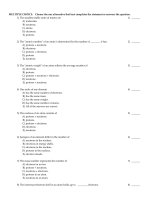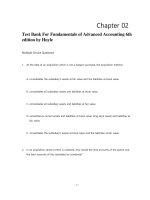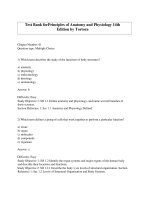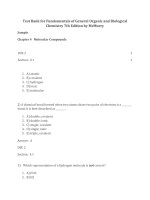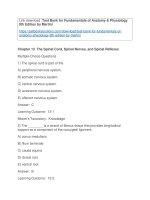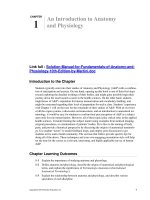Test bank for fundamentals of anatomy and physiology 11e c07
Bạn đang xem bản rút gọn của tài liệu. Xem và tải ngay bản đầy đủ của tài liệu tại đây (449.52 KB, 33 trang )
Chapterȱ7
TheȱAxialȱSkeleton
Multiple Choice Questions
1) Whichȱofȱtheȱfollowingȱisȱnotȱtrueȱregardingȱtheȱaxialȱskeleton?
A) hasȱ80ȱbones
B) includesȱtheȱskull
C) includesȱtheȱpelvicȱandȱpectoralȱgirdles
D) includesȱauditoryȱossicles
E) includesȱtheȱthoracicȱcage
Answer: C
LearningȱOutcome: 7-1
BloomȇsȱTaxonomy: Remembering
2) Whichȱofȱtheȱfollowingȱisȱaȱfunctionȱofȱtheȱaxialȱskeleton?
A) providesȱanȱattachmentȱforȱmusclesȱthatȱmoveȱtheȱappendicularȱskeleton
B) providesȱanȱattachmentȱforȱmusclesȱthatȱmoveȱtheȱhead,ȱneck,ȱandȱtrunk
C) providesȱanȱattachmentȱforȱmusclesȱinvolvedȱinȱbreathing
D) providesȱprotectionȱforȱtheȱbrainȱandȱspinalȱcord
E) Allȱofȱtheȱanswersȱareȱcorrect.
Answer: E
LearningȱOutcome: 7-1
BloomȇsȱTaxonomy: Remembering
3) Whichȱofȱtheȱfollowingȱisȱnotȱpartȱofȱtheȱaxialȱskeleton?
A) skull
B) falseȱribs
C) sternum
D) hyoidȱbone
E) pelvicȱgirdle
Answer: E
LearningȱOutcome: 7-1
BloomȇsȱTaxonomy: Remembering
4) Theȱskullȱandȱvertebralȱcolumnȱareȱpartȱofȱtheȱ________ȱskeleton.
A) axial
B) apical
C) appendicular
D) articulated
E) sagittal
Answer: A
LearningȱOutcome: 7-1
BloomȇsȱTaxonomy: Remembering
Copyrightȱ©ȱ2018ȱPearsonȱEducation,ȱInc.
202ȱȱȱTestȱBankȱforȱFundamentalsȱofȱAnatomyȱ&ȱPhysiology,ȱ11e
5) Identifyȱtheȱmismatchedȱpair.
A) skullȱbones:ȱ8ȱcranialȱandȱ14ȱfacialȱbones
B) bonesȱassociatedȱwithȱtheȱskull:ȱ6ȱauditoryȱossiclesȱandȱ1ȱhyoidȱbone
C) vertebralȱcolumn:ȱ24ȱvertebraeȱandȱ1ȱsacrumȱandȱ1ȱcoccyx
D) thoracicȱcage:ȱsternumȱandȱ24ȱribsȱandȱ2ȱclavicles
E) Thereȱisȱnoȱmismatchedȱpair.
Answer: D
LearningȱOutcome: 7-1
BloomȇsȱTaxonomy: Understanding
6) Inȱsomeȱindividualsȱtheȱsupra-orbitalȱforamenȱisȱincompleteȱandȱcalledȱthe
A) supra-orbitalȱfissure.
B) supra-orbitalȱsuture.
C) supra-orbitalȱfontanelle.
D) supra-orbitalȱnotch.
E) supra-orbitalȱmeatus.
Answer: D
LearningȱOutcome: 7-2
BloomȇsȱTaxonomy: Remembering
7) Theȱolfactoryȱforaminaȱareȱfoundȱinȱwhichȱofȱtheȱfollowingȱbones?
A) ethmoid
B) sphenoid
C) temporal
D) nasal
E) zygomatic
Answer: A
LearningȱOutcome: 7-2
BloomȇsȱTaxonomy: Remembering
8) Aȱthickeningȱofȱtheȱfrontalȱboneȱthatȱhelpsȱprotectȱtheȱeyeȱisȱthe
A) opticȱcanal.
B) supra-orbitalȱmargin.
C) superiorȱorbitalȱfissure.
D) frontalȱsuture.
E) frontalȱsinuses.
Answer: B
LearningȱOutcome: 7-2
BloomȇsȱTaxonomy: Understanding
9) Whichȱportionȱofȱtheȱtemporalȱboneȱhousesȱtheȱstructuresȱofȱtheȱinternalȱear?
A) squamous
B) petrous
C) styloid
D) zygomatic
E) mastoid
Answer: B
LearningȱOutcome: 7-2
BloomȇsȱTaxonomy: Understanding
Copyrightȱ©ȱ2018ȱPearsonȱEducation,ȱInc.
Chapterȱ7ȱȱTheȱAxialȱSkeletonȱȱȱ203
10) Whichȱpairedȱbonesȱformȱtheȱlateral,ȱposteriorȱportionsȱofȱtheȱcranium?
A) frontal
B) maxilla
C) sphenoid
D) parietal
E) zygomatic
Answer: D
LearningȱOutcome: 7-2
BloomȇsȱTaxonomy: Remembering
11) Delicateȱprojectionsȱthatȱformȱfromȱtheȱethmoidalȱlabyrinthȱare
A) olfactoryȱforamina.
B) pterygoidȱprocesses.
C) sphenoidalȱsinuses.
D) superiorȱandȱmiddleȱnasalȱconchae.
E) auditoryȱossicles.
Answer: D
LearningȱOutcome: 7-2
BloomȇsȱTaxonomy: Understanding
12) Whichȱofȱtheȱfollowingȱisȱnotȱaȱcranialȱbone?
A) frontal
B) parietal
C) palatine
D) temporal
E) occipital
Answer: C
LearningȱOutcome: 7-2
BloomȇsȱTaxonomy: Remembering
13) Air-filledȱchambersȱfoundȱinȱseveralȱbonesȱofȱtheȱskullȱareȱcalled
A) conchae.
B) sinuses.
C) fontanelles.
D) sutures.
E) fossae.
Answer: B
LearningȱOutcome: 7-2
BloomȇsȱTaxonomy: Remembering
14) Whichȱofȱtheȱfollowingȱpairsȱisȱmismatched?
A) mandible:ȱmovableȱfacialȱboneȱinȱskull
B) maxilla:ȱalveolarȱprocesses
C) sphenoid:ȱexternalȱacousticȱmeatus
D) frontal:ȱglabella
E) occipital:ȱforamenȱmagnum
Answer: C
LearningȱOutcome: 7-2
BloomȇsȱTaxonomy: Understanding
Copyrightȱ©ȱ2018ȱPearsonȱEducation,ȱInc.
204ȱȱȱTestȱBankȱforȱFundamentalsȱofȱAnatomyȱ&ȱPhysiology,ȱ11e
15) Whichȱofȱtheȱfollowingȱarticulateȱinȱtheȱmandibularȱfossa?
A) condylarȱprocess
B) mastoidȱprocess
C) acromionȱprocess
D) coronoidȱprocess
E) zygomaticȱprocess
Answer: A
LearningȱOutcome: 7-2
BloomȇsȱTaxonomy: Remembering
16) Theȱinternalȱacousticȱmeatusȱisȱlocatedȱinȱwhichȱbone?
A) occipital
B) ethmoid
C) sphenoid
D) temporal
E) parietal
Answer: D
LearningȱOutcome: 7-2
BloomȇsȱTaxonomy: Remembering
17) Theȱoccipitalȱ________ȱareȱwhereȱtheȱoccipitalȱboneȱarticulatesȱwithȱtheȱfirstȱcervicalȱvertebra.
A) processes
B) condyles
C) foramina
D) fossae
E) tubercles
Answer: B
LearningȱOutcome: 7-2
BloomȇsȱTaxonomy: Remembering
18) Theȱauditoryȱossiclesȱareȱhousedȱinȱwhichȱcranialȱbone?
A) sphenoid
B) ethmoid
C) zygomatic
D) temporal
E) lacrimal
Answer: D
LearningȱOutcome: 7-2
BloomȇsȱTaxonomy: Remembering
19) Theȱparietalȱbonesȱandȱoccipitalȱboneȱarticulateȱatȱtheȱ________ȱsuture.
A) lambdoid
B) central
C) sagittal
D) coronal
E) posterior
Answer: A
LearningȱOutcome: 7-2
BloomȇsȱTaxonomy: Remembering
Copyrightȱ©ȱ2018ȱPearsonȱEducation,ȱInc.
Chapterȱ7ȱȱTheȱAxialȱSkeletonȱȱȱ205
20) Theȱ________ȱisȱtheȱbonyȱchamberȱthatȱprotectsȱandȱsupportsȱtheȱbrain.
A) skull
B) centrum
C) cranium
D) cephalum
E) cortex
Answer: C
LearningȱOutcome: 7-2
BloomȇsȱTaxonomy: Understanding
21) Infectionȱofȱtheȱlargeȱprocessȱonȱtheȱtemporalȱboneȱwouldȱbeȱcalled
A) tinnitus.
B) encephalitis.
C) meningitis.
D) petrositis.
E) mastoiditis.
Answer: E
LearningȱOutcome: 7-2
BloomȇsȱTaxonomy: Applying
22) Theȱinferiorȱportionȱofȱtheȱnasalȱseptumȱisȱformedȱbyȱthe
A) nasalȱbone.
B) perpendicularȱplateȱofȱtheȱethmoidȱbone.
C) inferiorȱnasalȱconchae.
D) vomer.
E) palatineȱbone.
Answer: D
LearningȱOutcome: 7-2
BloomȇsȱTaxonomy: Remembering
23) Theȱopticȱnerveȱpassesȱthroughȱwhichȱstructure?
A) superiorȱorbitalȱfissure
B) inferiorȱorbitalȱfissure
C) opticȱcanal
D) internalȱopticȱmeatus
E) externalȱacousticȱmeatus
Answer: C
LearningȱOutcome: 7-2
BloomȇsȱTaxonomy: Remembering
24) Theȱfourȱprimaryȱsuturesȱareȱlambdoid,ȱcoronal,ȱsagittal,ȱand
A) lateral.
B) cuboidal.
C) parietal.
D) squamous.
E) frontal.
Answer: D
LearningȱOutcome: 7-2
BloomȇsȱTaxonomy: Remembering
Copyrightȱ©ȱ2018ȱPearsonȱEducation,ȱInc.
206ȱȱȱTestȱBankȱforȱFundamentalsȱofȱAnatomyȱ&ȱPhysiology,ȱ11e
25) Theȱ________ȱboneȱisȱunusualȱbecauseȱitȱdoesnȇtȱcontactȱanotherȱbone.
A) vomer
B) lacrimal
C) hyoid
D) atlas
E) ethmoid
Answer: C
LearningȱOutcome: 7-2
BloomȇsȱTaxonomy: Remembering
26) Theȱhardȱpalateȱofȱtheȱroofȱofȱtheȱmouthȱisȱmostlyȱformedȱbyȱthe
A) palatineȱprocessesȱofȱtheȱmaxillae.
B) lesserȱwingsȱofȱtheȱsphenoidȱbone.
C) nasalȱbones.
D) zygomaticȱprocess.
E) palatineȱbones.
Answer: A
LearningȱOutcome: 7-2
BloomȇsȱTaxonomy: Remembering
27) Theȱforamenȱmagnumȱisȱfoundȱinȱtheȱ________ȱbone.
A) frontal
B) parietal
C) ethmoid
D) occipital
E) temporal
Answer: D
LearningȱOutcome: 7-2
BloomȇsȱTaxonomy: Remembering
28) Theȱsutureȱthatȱformsȱtheȱarticulationȱofȱtheȱparietalȱbonesȱwithȱtheȱfrontalȱboneȱisȱthe
________ȱsuture.
A) lambdoid
B) rostral
C) coronal
D) squamous
E) sagittal
Answer: C
LearningȱOutcome: 7-2
BloomȇsȱTaxonomy: Remembering
29) Theȱcalvariaȱ(orȱskullcap)ȱisȱformedȱbyȱtheȱ________ȱbones.
A) frontal,ȱtemporal,ȱandȱparietal
B) frontal,ȱparietal,ȱandȱoccipital
C) temporal,ȱparietal,ȱandȱoccipital
D) frontal,ȱtemporal,ȱandȱoccipital
E) frontal,ȱtemporal,ȱparietal,ȱandȱoccipital
Answer: B
LearningȱOutcome: 7-2
BloomȇsȱTaxonomy: Remembering
Copyrightȱ©ȱ2018ȱPearsonȱEducation,ȱInc.
Chapterȱ7ȱȱTheȱAxialȱSkeletonȱȱȱ207
30) Theȱzygomaticȱarchȱisȱformedȱbyȱtheȱarticulationȱofȱprocessesȱfromȱwhichȱtwoȱbones?
A) zygomaticȱandȱmaxilla
B) frontalȱandȱtemporal
C) sphenoidȱandȱtemporal
D) zygomaticȱandȱsphenoid
E) temporalȱandȱzygomatic
Answer: E
LearningȱOutcome: 7-2
BloomȇsȱTaxonomy: Remembering
31) Theȱprominentȱbulgeȱjustȱposteriorȱandȱinferiorȱtoȱtheȱexternalȱauditoryȱmeatusȱisȱthe
A) mastoidȱprocess.
B) styloidȱprocess.
C) occipitalȱcondyle.
D) condyloidȱprocess.
E) temporalȱprocess.
Answer: A
LearningȱOutcome: 7-2
BloomȇsȱTaxonomy: Remembering
32) Whichȱofȱtheseȱisȱnotȱoneȱofȱtheȱfacialȱbones?
A) frontal
B) maxilla
C) vomer
D) mandible
E) zygomatic
Answer: A
LearningȱOutcome: 7-2
BloomȇsȱTaxonomy: Remembering
33) Eachȱofȱtheȱfollowingȱregions/markingsȱisȱassociatedȱwithȱtheȱoccipitalȱboneȱexceptȱthe
A) superiorȱandȱinferiorȱnuchalȱlines.
B) foramenȱmagnum.
C) hypoglossalȱcanals.
D) glabella.
E) externalȱoccipitalȱcrest.
Answer: D
LearningȱOutcome: 7-2
BloomȇsȱTaxonomy: Remembering
34) Aȱpointȱofȱattachmentȱforȱmusclesȱthatȱrotateȱorȱextendȱtheȱheadȱisȱthe
A) styloidȱprocess.
B) mastoidȱprocess.
C) palatineȱprocess.
D) coronoidȱprocess.
E) zygomaticȱprocess.
Answer: B
LearningȱOutcome: 7-2
BloomȇsȱTaxonomy: Remembering
Copyrightȱ©ȱ2018ȱPearsonȱEducation,ȱInc.
208ȱȱȱTestȱBankȱforȱFundamentalsȱofȱAnatomyȱ&ȱPhysiology,ȱ11e
35) Ligamentsȱthatȱsupportȱtheȱhyoidȱboneȱareȱattachedȱtoȱthe
A) styloidȱprocess.
B) mastoidȱprocess.
C) palatineȱprocess.
D) coronoidȱprocess.
E) zygomaticȱprocess.
Answer: A
LearningȱOutcome: 7-2
BloomȇsȱTaxonomy: Remembering
36) Eachȱofȱtheȱfollowingȱisȱassociatedȱwithȱtheȱtemporalȱbone except the
A) mastoidȱcells.
B) petrousȱportion.
C) sellaȱturcica.
D) internalȱacousticȱmeatus.
E) mandibularȱfossa.
Answer: C
LearningȱOutcome: 7-2
BloomȇsȱTaxonomy: Understanding
37) Theȱhypophysealȱfossaȱofȱtheȱsellaȱturcicaȱcontainsȱtheȱ________ȱgland.
A) lacrimal
B) pituitary
C) olfactory
D) nasal
E) sellar
Answer: B
LearningȱOutcome: 7-2
BloomȇsȱTaxonomy: Remembering
38) Eachȱofȱtheȱfollowingȱstructuresȱisȱassociatedȱwithȱtheȱsphenoidȱbone exceptȱthe
A) foramenȱovale.
B) opticȱcanals.
C) pterygoidȱprocesses.
D) sellaȱturcica.
E) cribriformȱplate.
Answer: E
LearningȱOutcome: 7-2
BloomȇsȱTaxonomy: Understanding
39) Aȱskullȱboneȱthatȱcouldȱbeȱdescribedȱasȱlookingȱlikeȱaȱbatȱwithȱwingsȱextendedȱisȱthe
A) maxilla.
B) cristaȱgalli.
C) sphenoid.
D) ethmoid.
E) temporal.
Answer: C
LearningȱOutcome: 7-2
BloomȇsȱTaxonomy: Remembering
Copyrightȱ©ȱ2018ȱPearsonȱEducation,ȱInc.
Chapterȱ7ȱȱTheȱAxialȱSkeletonȱȱȱ209
40) Theȱnasalȱconchae
A) attachȱmusclesȱthatȱmoveȱtheȱeye.
B) containȱtheȱnervesȱforȱolfaction.
C) createȱturbulenceȱinȱtheȱnasalȱpassageways.
D) protectȱtheȱpituitaryȱgland.
E) attachȱmusclesȱthatȱmoveȱtheȱmouth.
Answer: C
LearningȱOutcome: 7-2
BloomȇsȱTaxonomy: Remembering
41) Theȱbonyȱportionȱofȱtheȱnasalȱseptumȱisȱformedȱbyȱthe
A) nasalȱbones.
B) perpendicularȱplateȱofȱtheȱethmoidȱbone.
C) perpendicularȱplateȱofȱtheȱethmoidȱandȱvomerȱbone.
D) vomerȱandȱsphenoidȱbone.
E) perpendicularȱplateȱofȱtheȱethmoidȱandȱsphenoidȱbone.
Answer: C
LearningȱOutcome: 7-2
BloomȇsȱTaxonomy: Remembering
42) Ofȱtheȱfollowingȱbones,ȱwhichȱisȱunpaired?
A) vomer
B) maxillae
C) palatine
D) nasal
E) lacrimal
Answer: A
LearningȱOutcome: 7-2
BloomȇsȱTaxonomy: Remembering
43) Theȱstyloidȱprocess,ȱzygomaticȱprocess,ȱandȱauditoryȱossiclesȱareȱassociatedȱwithȱthe
A) parietalȱbone.
B) occipitalȱbone.
C) sphenoidȱbone.
D) temporalȱbone.
E) lacrimalȱbone.
Answer: D
LearningȱOutcome: 7-2
BloomȇsȱTaxonomy: Remembering
44) Theȱskullȱcontainsȱ________ȱbones.
A) 32
B) 22
C) 42
D) 12
E) 27
Answer: B
LearningȱOutcome: 7-2
BloomȇsȱTaxonomy: Remembering
Copyrightȱ©ȱ2018ȱPearsonȱEducation,ȱInc.
210ȱȱȱTestȱBankȱforȱFundamentalsȱofȱAnatomyȱ&ȱPhysiology,ȱ11e
45) Whileȱplayingȱsoftball,ȱGinaȱisȱstruckȱinȱtheȱfrontalȱboneȱbyȱaȱwildȱpitch.ȱWhichȱofȱthe
followingȱcomplaintsȱwouldȱyouȱexpectȱherȱtoȱhave?
A) aȱsoreȱjaw
B) aȱblackȱeye
C) aȱheadache
D) aȱsoreȱchest
E) aȱsoreȱback
Answer: C
LearningȱOutcome: 7-2
BloomȇsȱTaxonomy: Applying
46) Theȱalveolarȱprocessesȱofȱtheȱmandible
A) supportȱtheȱupperȱteeth.
B) supportȱtheȱlowerȱteeth.
C) anchorȱtheȱtongue.
D) areȱpartȱofȱtheȱtemporomandibularȱjoint.
E) articulateȱwithȱtheȱhyoidȱbone.
Answer: B
LearningȱOutcome: 7-2
BloomȇsȱTaxonomy: Remembering
47) Theȱsmallestȱfacialȱbonesȱareȱthe
A) ethmoidȱbones.
B) lacrimalȱbones.
C) lacerumȱbones.
D) nasalȱbones.
E) zygomaticȱbones.
Answer: B
LearningȱOutcome: 7-2
BloomȇsȱTaxonomy: Understanding
48) Ridgesȱthatȱanchorȱmusclesȱthatȱstabilizeȱtheȱheadȱareȱthe
A) anteriorȱandȱposteriorȱnuchalȱlines.
B) anteriorȱandȱsuperiorȱnuchalȱlines.
C) inferiorȱandȱsuperiorȱnuchalȱlines.
D) medialȱandȱlateralȱnuchalȱlines.
E) cranialȱandȱcaudalȱnuchalȱlines.
Answer: C
LearningȱOutcome: 7-2
BloomȇsȱTaxonomy: Remembering
49) Theȱhyoidȱbone
A) attachesȱtoȱtongueȱmuscles.
B) isȱlinkedȱtoȱtheȱstyloidȱprocessȱbyȱaȱligament.
C) isȱsuperiorȱtoȱtheȱlarynx.
D) doesȱnotȱdirectlyȱarticulateȱwithȱotherȱbones.
E) Allȱofȱtheȱanswersȱareȱcorrect.
Answer: E
LearningȱOutcome: 7-2
BloomȇsȱTaxonomy: Understanding
Copyrightȱ©ȱ2018ȱPearsonȱEducation,ȱInc.
Chapterȱ7ȱȱTheȱAxialȱSkeletonȱȱȱ211
50) Damageȱtoȱtheȱtemporalȱboneȱwouldȱmostȱlikelyȱaffectȱtheȱsense(s)ȱof
A) balance.
B) hearingȱandȱbalance.
C) smellȱandȱtaste.
D) vision.
E) touchȱandȱpressure.
Answer: B
LearningȱOutcome: 7-2
BloomȇsȱTaxonomy: Understanding
51) Prematureȱclosureȱofȱtheȱsagittalȱsutureȱwouldȱresultȱin
A) aȱlongȱandȱnarrowȱhead.
B) aȱveryȱbroadȱhead.
C) anȱunusuallyȱsmallȱhead.
D) aȱdistortedȱheadȱwithȱoneȱsideȱbeingȱlongerȱthanȱtheȱother.
E) death.
Answer: A
LearningȱOutcome: 7-2
BloomȇsȱTaxonomy: Applying
52) Duringȱdevelopmentȱaȱcleftȱpalateȱformsȱwhenȱwhichȱbonesȱfailȱtoȱmeetȱalongȱtheȱmidlineȱof
theȱhardȱpalate?
A) temporal
B) maxillae
C) zygomatic
D) sphenoid
E) ethmoid
Answer: B
LearningȱOutcome: 7-2
BloomȇsȱTaxonomy: Applying
53) Kristenȱwentȱtoȱtheȱdentistȱcomplainingȱofȱjawȱtendernessȱandȱpoppingȱnoisesȱwhenȱsheȱopens
andȱclosesȱherȱmouth.ȱHeȱnoticesȱabnormalȱwearingȱonȱtheȱarticulatingȱsurfacesȱofȱherȱteeth.
Whichȱofȱtheȱfollowingȱconditionsȱdoesȱsheȱmostȱlikelyȱsufferȱfrom?
A) deviatedȱnasalȱseptum
B) cleftȱpalate
C) temporomandibularȱjointȱsyndrome
D) dislocatedȱjaw
E) sinusitis
Answer: C
LearningȱOutcome: 7-2
BloomȇsȱTaxonomy: Applying
Copyrightȱ©ȱ2018ȱPearsonȱEducation,ȱInc.
212ȱȱȱTestȱBankȱforȱFundamentalsȱofȱAnatomyȱ&ȱPhysiology,ȱ11e
54) Jackȱgetsȱintoȱaȱfightȱandȱisȱpunchedȱinȱtheȱnose.ȱWhichȱofȱtheȱfollowingȱbonesȱmightȱbe
fractured?
A) ethmoidȱbone
B) zygomaticȱbone
C) temporalȱbone
D) mandible
E) parietalȱbone
Answer: A
LearningȱOutcome: 7-2
BloomȇsȱTaxonomy: Applying
55) Asȱtheȱresultȱofȱanȱaccident,ȱBillȱsuffersȱaȱdislocatedȱjaw.ȱThisȱinjuryȱwouldȱinvolveȱthe
A) stylohyoidȱligaments.
B) hyoidȱbone.
C) condylarȱprocessȱofȱtheȱmandible.
D) alveolarȱprocessȱofȱtheȱmandible.
E) greaterȱhornȱofȱtheȱhyoidȱbone.
Answer: C
LearningȱOutcome: 7-2
BloomȇsȱTaxonomy: Applying
56) YourȱfriendȱGregȱisȱhitȱinȱtheȱjawȱandȱwhenȱlookingȱatȱhim,ȱhisȱfaceȱlooksȱmisaligned.ȱYou
immediatelyȱtakeȱhimȱtoȱtheȱemergencyȱroomȱandȱareȱnotȱsurprisedȱtoȱlearnȱthatȱheȱhasȱa
broken
A) temporalȱbone.
B) zygomaticȱbone.
C) mandible.
D) externalȱauditoryȱmeatus.
E) clavicle.
Answer: C
LearningȱOutcome: 7-2
BloomȇsȱTaxonomy: Applying
Copyrightȱ©ȱ2018ȱPearsonȱEducation,ȱInc.
Chapterȱ7ȱȱTheȱAxialȱSkeletonȱȱȱ213
Figureȱ7-1ȱFloorȱofȱtheȱCranialȱCavity
UseȱFigureȱ7-1ȱtoȱanswerȱtheȱfollowingȱquestions:
57) Whichȱboneȱstructureȱhasȱforaminaȱforȱtheȱolfactoryȱnerves?
A) 1
B) 2
C) 3
D) 8
E) 5
Answer: E
LearningȱOutcome: 7-2
BloomȇsȱTaxonomy: Analyzing
58) Identifyȱtheȱsphenoidȱbone.
A) 1
B) 2
C) 3
D) 4
E) 5
Answer: B
LearningȱOutcome: 7-2
BloomȇsȱTaxonomy: Analyzing
Copyrightȱ©ȱ2018ȱPearsonȱEducation,ȱInc.
214ȱȱȱTestȱBankȱforȱFundamentalsȱofȱAnatomyȱ&ȱPhysiology,ȱ11e
59) Whichȱstructureȱenclosesȱtheȱpituitaryȱgland?
A) 4
B) 5
C) 6
D) 7
E) 8
Answer: C
LearningȱOutcome: 7-2
BloomȇsȱTaxonomy: Analyzing
60) WhatȱisȱtheȱnameȱofȱtheȱstructureȱlabeledȱȈ7Ȉ?
A) opticȱcanal
B) foramenȱspinosum
C) foramenȱrotundum
D) foramenȱlacerum
E) foramenȱovale
Answer: C
LearningȱOutcome: 7-2
BloomȇsȱTaxonomy: Analyzing
61) WhatȱisȱtheȱnameȱofȱtheȱstructureȱlabeledȱȈ8Ȉ?
A) sellaȱturcica
B) foramenȱovale
C) foramenȱrotundum
D) carotidȱcanal
E) foramenȱspinosum
Answer: B
LearningȱOutcome: 7-2
BloomȇsȱTaxonomy: Analyzing
62) Theȱfacialȱnerveȱ(VII)ȱpassesȱthroughȱtheȱinternalȱacousticȱmeatusȱandȱthenȱthroughȱthe
A) mastoidȱforamen.
B) stylomastoidȱforamen.
C) jugularȱforamen.
D) carotidȱforamen.
E) foramenȱlacerum.
Answer: B
LearningȱOutcome: 7-2
BloomȇsȱTaxonomy: Remembering
63) Theȱlargeȱforamenȱthatȱservesȱasȱaȱpassagewayȱforȱtheȱmedullaȱofȱtheȱbrainȱandȱtheȱaccessory
nerveȱ(XI)ȱisȱthe
A) foramenȱlacerum.
B) foramenȱrotundum.
C) carotidȱcanal.
D) jugularȱforamen.
E) foramenȱmagnum.
Answer: E
LearningȱOutcome: 7-2
BloomȇsȱTaxonomy: Remembering
Copyrightȱ©ȱ2018ȱPearsonȱEducation,ȱInc.
Chapterȱ7ȱȱTheȱAxialȱSkeletonȱȱȱ215
64) Nervesȱcarryingȱsensoryȱinformationȱfromȱtheȱlipsȱandȱtheȱchinȱpassȱthroughȱthe
A) ramusȱofȱtheȱmandible.
B) condylarȱprocess.
C) mentalȱforamina.
D) mandibularȱforamen.
E) maxillaryȱforamina.
Answer: C
LearningȱOutcome: 7-2
BloomȇsȱTaxonomy: Remembering
65) Theȱ________ȱpassesȱthroughȱtheȱ________.
A) vagusȱnerve;ȱforamenȱmagnum
B) opticȱnerve;ȱforamenȱovale
C) vestibulocochlearȱnerve;ȱexternalȱacousticȱmeatus
D) internalȱjugularȱvein;ȱjugularȱforamen
E) internalȱcarotidȱartery;ȱjugularȱforamen
Answer: D
LearningȱOutcome: 7-2
BloomȇsȱTaxonomy: Remembering
66) Theȱnasalȱcomplexȱincludesȱtheȱbonesȱthatȱencloseȱtheȱnasalȱcavityȱandȱtheȱ________ȱsinuses.
A) hyponasal
B) paranasal
C) endonasal
D) epinasal
E) intranasal
Answer: B
LearningȱOutcome: 7-3
BloomȇsȱTaxonomy: Remembering
67) Sinusȱinflammationȱisȱcalled
A) sinusitis.
B) asthma.
C) congestion.
D) postnasalȱdrip.
E) encephalitis.
Answer: A
LearningȱOutcome: 7-3
BloomȇsȱTaxonomy: Applying
68) Eachȱofȱtheȱfollowingȱbonesȱisȱaȱcomponentȱofȱtheȱorbitalȱcomplex exceptȱtheȱ________ȱbone.
A) lacrimal
B) nasal
C) sphenoid
D) ethmoid
E) frontal
Answer: B
LearningȱOutcome: 7-3
BloomȇsȱTaxonomy: Understanding
Copyrightȱ©ȱ2018ȱPearsonȱEducation,ȱInc.
216ȱȱȱTestȱBankȱforȱFundamentalsȱofȱAnatomyȱ&ȱPhysiology,ȱ11e
69) Theȱgreaterȱwingsȱofȱwhichȱboneȱformȱaȱlargeȱportionȱofȱtheȱposteriorȱwallȱorbit?
A) lacrimal
B) ethmoid
C) sphenoid
D) nasal
E) zygomatic
Answer: C
LearningȱOutcome: 7-3
BloomȇsȱTaxonomy: Understanding
70) Howȱmanyȱbonesȱmakeȱupȱtheȱorbitalȱcomplex?
A) 3
B) 4
C) 5
D) 6
E) 7
Answer: E
LearningȱOutcome: 7-3
BloomȇsȱTaxonomy: Remembering
71) Theȱnasalȱcomplexȱconsistsȱofȱallȱofȱtheȱfollowingȱbones except the
A) zygomatic.
B) ethmoid.
C) sphenoid.
D) frontal.
E) maxillary.
Answer: A
LearningȱOutcome: 7-3
BloomȇsȱTaxonomy: Remembering
72) Whichȱstatement(s)ȱaboutȱtheȱfunctionsȱofȱtheȱparanasalȱsinusesȱis/areȱnotȱtrue?
A) Theyȱprovideȱanȱextensiveȱareaȱofȱmucousȱepithelium.
B) Theyȱmakeȱskullȱbonesȱlighter.
C) Theȱmucusȱtheyȱsecreteȱentersȱtheȱoralȱcavities.
D) Theyȱsupportȱciliaȱthatȱmoveȱtheȱmucus.
E) Theyȱareȱlocatedȱinȱtheȱsphenoid,ȱethmoid,ȱfrontal,ȱpalatineȱandȱmaxillae.
Answer: C
LearningȱOutcome: 7-3
BloomȇsȱTaxonomy: Understanding
73) Theȱfloorȱofȱtheȱorbitalȱcomplexȱisȱformedȱmainlyȱbyȱthe
A) maxilla.
B) ethmoid.
C) zygomatic.
D) sphenoid.
E) frontal.
Answer: A
LearningȱOutcome: 7-3
BloomȇsȱTaxonomy: Remembering
Copyrightȱ©ȱ2018ȱPearsonȱEducation,ȱInc.
Chapterȱ7ȱȱTheȱAxialȱSkeletonȱȱȱ217
74) Theȱlargestȱsinusȱisȱwithinȱwhichȱbone?
A) nasal
B) sphenoid
C) ethmoid
D) frontal
E) maxilla
Answer: E
LearningȱOutcome: 7-3
BloomȇsȱTaxonomy: Remembering
75) Theȱrole(s)ȱofȱtheȱsinusesȱinclude(s)
A) makingȱtheȱskullȱlighter.
B) productionȱofȱmucusȱthatȱmoistensȱandȱcleansȱtheȱair.
C) increasingȱsurfaceȱareaȱforȱgasȱexchange.
D) extraȱsourceȱofȱairȱandȱincreasingȱsurfaceȱareaȱforȱgasȱexchange.
E) makingȱtheȱskullȱlighterȱandȱproductionȱofȱmucusȱthatȱmoistensȱandȱcleansȱtheȱair.
Answer: E
LearningȱOutcome: 7-3
BloomȇsȱTaxonomy: Understanding
76) Aȱbentȱnasalȱseptumȱthatȱslowsȱorȱpreventsȱsinusȱdrainageȱisȱknownȱclinicallyȱasȱaȱ________
septum.
A) deviated
B) crooked
C) obstructive
D) deviant
E) restrictive
Answer: A
LearningȱOutcome: 7-3
BloomȇsȱTaxonomy: Applying
77) Suturesȱcanȱbeȱfoundȱatȱallȱofȱtheȱjointsȱofȱanȱadultȱskull exceptȱbetween
A) theȱmandibleȱandȱtheȱcranium.
B) theȱzygomaticȱboneȱandȱtheȱmaxillaryȱbone.
C) theȱoccipitalȱboneȱandȱtheȱparietalȱbone.
D) theȱvomerȱandȱtheȱzygomaticȱbone.
E) theȱsphenoidȱboneȱandȱtheȱethmoidȱbone.
Answer: A
LearningȱOutcome: 7-3
BloomȇsȱTaxonomy: Understanding
Copyrightȱ©ȱ2018ȱPearsonȱEducation,ȱInc.
218ȱȱȱTestȱBankȱforȱFundamentalsȱofȱAnatomyȱ&ȱPhysiology,ȱ11e
78) Theȱconditionȱinȱwhichȱdistortionsȱofȱtheȱskullȱoccurȱdueȱtoȱtheȱprematureȱclosureȱof
fontanellesȱisȱcalled
A) anencephaly.
B) microcephaly.
C) craniostenosis.
D) membranitis.
E) epicranialȱblock.
Answer: C
LearningȱOutcome: 7-4
BloomȇsȱTaxonomy: Applying
79) Inȱtheȱconditionȱknownȱasȱ________,ȱprematureȱclosureȱofȱallȱofȱtheȱcranialȱsuturesȱresultsȱin
restrictedȱbrainȱgrowthȱandȱanȱundersizedȱhead.
A) anencephaly
B) microcephaly
C) craniostenosis
D) membranitis
E) epicranialȱblock
Answer: B
LearningȱOutcome: 7-4
BloomȇsȱTaxonomy: Applying
80) Eachȱofȱtheȱfollowingȱstatementsȱconcerningȱtheȱdevelopmentȱofȱtheȱskullȱisȱtrue ȱexceptȱthat
A) allȱtheȱbonesȱofȱtheȱskullȱdevelopȱfromȱoneȱsingleȱossificationȱcenter.
B) atȱbirthȱtheȱcranialȱbonesȱareȱconnectedȱbyȱareasȱofȱfibrousȱconnectiveȱtissue.
C) theȱgrowthȱofȱtheȱcraniumȱisȱusuallyȱcoordinatedȱwithȱtheȱgrowthȱofȱtheȱbrain.
D) theȱskullsȱofȱinfantsȱandȱadultsȱdifferȱinȱshapeȱandȱstructureȱofȱtheȱskeletalȱelements.
E) theȱmostȱsignificantȱgrowthȱofȱtheȱskullȱoccursȱbeforeȱtheȱageȱofȱ5.
Answer: A
LearningȱOutcome: 7-4
BloomȇsȱTaxonomy: Understanding
81) Whichȱtwoȱfontanellesȱformȱalongȱtheȱsagittalȱsuture?
A) anteriorȱandȱsphenoidal
B) anteriorȱandȱposterior
C) posteriorȱandȱsphenoidal
D) anteriorȱandȱmastoid
E) posteriorȱandȱmastoid
Answer: B
LearningȱOutcome: 7-4
BloomȇsȱTaxonomy: Remembering
Copyrightȱ©ȱ2018ȱPearsonȱEducation,ȱInc.
Chapterȱ7ȱȱTheȱAxialȱSkeletonȱȱȱ219
82) Identifyȱtheȱcorrectȱstatementȱregardingȱfontanelles.
A) Theyȱformȱfibrousȱconnectionsȱbetweenȱfacialȱbones.
B) Theyȱpersistȱthroughoutȱchildhood.
C) Theyȱenableȱeasierȱdeliveryȱthroughȱtheȱbirthȱcanal.
D) Theȱoccipitalȱfontanellesȱareȱalsoȱknownȱasȱtheȱsoftȱspot.
E) Theȱsphenoidalȱfontanellesȱareȱtheȱlargest.
Answer: C
LearningȱOutcome: 7-4
BloomȇsȱTaxonomy: Remembering
83) Theȱfibrousȱconnectiveȱtissueȱmembranesȱbetweenȱtheȱcranialȱbonesȱofȱtheȱfetalȱskullȱare
A) fontanelles.
B) sutures.
C) Wormianȱbones.
D) foramina.
E) fibrocartilaginousȱdiscs.
Answer: A
LearningȱOutcome: 7-4
BloomȇsȱTaxonomy: Remembering
84) Theȱmostȱsignificantȱskullȱgrowthȱoccursȱbeforeȱtheȱageȱof
A) 3.
B) 2.
C) 5.
D) 1.
E) 4.
Answer: C
LearningȱOutcome: 7-4
BloomȇsȱTaxonomy: Understanding
85) Whileȱyouȇreȱvisitingȱyourȱfriendȱwhoȱrecentlyȱgaveȱbirth,ȱsheȱcommentsȱonȱherȱinfantȇsȱsoft
spot.ȱYouȱthinkȱtoȱyourselfȱthatȱtheȱcorrectȱtermȱforȱtheȱȈsoftȱspotȈȱlocatedȱatȱtheȱintersectionȱof
theȱfrontal,ȱsagittal,ȱandȱcoronalȱsuturesȱis
A) sphenoidalȱfontanelle.
B) anteriorȱfontanelle.
C) occipitalȱfontanelle.
D) mastoidȱfontanelle.
E) cushionȱspot.
Answer: B
LearningȱOutcome: 7-4
BloomȇsȱTaxonomy: Applying
Copyrightȱ©ȱ2018ȱPearsonȱEducation,ȱInc.
220ȱȱȱTestȱBankȱforȱFundamentalsȱofȱAnatomyȱ&ȱPhysiology,ȱ11e
86) Theȱmostȱcommonȱdistortionȱofȱtheȱspinalȱcurvatureȱis
A) kyphosis.
B) lordosis.
C) scoliosis.
D) spinosis.
E) spinaȱbifida.
Answer: C
LearningȱOutcome: 7-5
BloomȇsȱTaxonomy: Remembering
87) Theȱfourȱcurvesȱofȱtheȱadultȱspinalȱcolumnȱareȱnotȱallȱpresentȱatȱbirth.ȱWhichȱofȱtheȱfollowing
areȱtheȱsecondaryȱcurves,ȱwhichȱdoȱnotȱappearȱuntilȱseveralȱmonthsȱlater?
A) cervicalȱandȱlumbar
B) thoracicȱandȱlumbar
C) sacralȱandȱlumbar
D) thoracicȱandȱsacral
E) cervicalȱandȱsacral
Answer: A
LearningȱOutcome: 7-5
BloomȇsȱTaxonomy: Remembering
88) Whatȱisȱtheȱpurposeȱofȱtheȱsecondaryȱcurves?
A) accommodateȱtheȱthoracicȱorgans
B) shiftȱtheȱweightȱofȱtheȱbodyȱtoȱpermitȱanȱuprightȱposture
C) accommodateȱtheȱabdominalȱorgans
D) formȱaȱhumpback
E) accommodateȱtheȱpelvicȱorgans
Answer: B
LearningȱOutcome: 7-5
BloomȇsȱTaxonomy: Understanding
89) Theȱfourȱspinalȱcurvesȱincludeȱallȱbutȱoneȱofȱtheȱfollowing.ȱIdentifyȱtheȱexception.
A) thoracic
B) cervical
C) lumbar
D) axial
E) sacral
Answer: D
LearningȱOutcome: 7-5
BloomȇsȱTaxonomy: Remembering
90) Theȱprimaryȱspinalȱcurves
A) areȱalsoȱcalledȱcompensationȱcurves.
B) accommodateȱtheȱthoracicȱandȱabdominopelvicȱviscera.
C) developȱseveralȱmonthsȱafterȱbirth.
D) areȱtheȱlumbarȱandȱcervicalȱcurves.
E) helpȱshiftȱtheȱweightȱtoȱpermitȱanȱuprightȱposture.
Answer: B
LearningȱOutcome: 7-5
BloomȇsȱTaxonomy: Understanding
Copyrightȱ©ȱ2018ȱPearsonȱEducation,ȱInc.
Chapterȱ7ȱȱTheȱAxialȱSkeletonȱȱȱ221
91) Successiveȱvertebraeȱarticulateȱatȱfacetsȱonȱtheȱinferiorȱarticularȱprocessesȱofȱtheȱsuperior
vertebraȱandȱfacetsȱonȱtheȱ________ȱofȱtheȱadjacentȱinferiorȱvertebrae.
A) dens
B) pedicles
C) lamellae
D) transverseȱprocesses
E) superiorȱarticularȱprocesses
Answer: E
LearningȱOutcome: 7-6
BloomȇsȱTaxonomy: Understanding
92) Theȱfiveȱvertebralȱregionsȱareȱtheȱcervical,ȱthoracic,ȱlumbar,ȱsacral,ȱand
A) medial.
B) proximal.
C) distal.
D) coccygeal.
E) osȱcoxal.
Answer: D
LearningȱOutcome: 7-6
BloomȇsȱTaxonomy: Remembering
93) Theȱfirstȱcervicalȱvertebraȱisȱcalledȱthe
A) primum.
B) atlas.
C) axis.
D) cervix.
E) apex.
Answer: B
LearningȱOutcome: 7-6
BloomȇsȱTaxonomy: Remembering
94) Theȱsecondȱcervicalȱvertebraȱisȱcalledȱthe
A) primum.
B) atlas.
C) axis.
D) cervix.
E) apex.
Answer: C
LearningȱOutcome: 7-6
BloomȇsȱTaxonomy: Remembering
Copyrightȱ©ȱ2018ȱPearsonȱEducation,ȱInc.
222ȱȱȱTestȱBankȱforȱFundamentalsȱofȱAnatomyȱ&ȱPhysiology,ȱ11e
95) Theȱtermȱ________ȱisȱusedȱtoȱdescribeȱanȱinjuryȱcausedȱbyȱdisplacementȱofȱtheȱcervical
vertebraeȱduringȱaȱsuddenȱchangeȱinȱbodyȱposition.
A) remodel
B) rearrangement
C) fracture
D) whiplash
E) adjustment
Answer: D
LearningȱOutcome: 7-6
BloomȇsȱTaxonomy: Applying
96) Theȱ________ȱallowȱforȱaȱwideȱrangeȱofȱheadȱmovements.
A) hyoidȱbones
B) temporomandibularȱjoints
C) cervicalȱvertebrae
D) intervertebralȱdiscs
E) occipitalȱcondyles
Answer: C
LearningȱOutcome: 7-6
BloomȇsȱTaxonomy: Understanding
97) Theȱvertebralȱcolumnȱcontainsȱ________ȱthoracicȱvertebrae.
A) 4
B) 5
C) 7
D) 12
E) 31
Answer: D
LearningȱOutcome: 7-6
BloomȇsȱTaxonomy: Remembering
98) Theȱvertebralȱarchȱisȱformedȱbyȱtheȱpediclesȱandȱthe
A) transverseȱspinousȱprocesses.
B) dorsalȱspinousȱprocesses.
C) laminae.
D) costalȱfacets.
E) intervertebralȱdisc.
Answer: C
LearningȱOutcome: 7-6
BloomȇsȱTaxonomy: Remembering
99) Theȱpartȱofȱtheȱvertebraeȱthatȱtransfersȱweightȱalongȱtheȱaxisȱofȱtheȱvertebralȱcolumnȱisȱthe
A) vertebralȱarch.
B) vertebralȱbody.
C) articularȱprocesses.
D) intervertebralȱspace.
E) transverseȱprocess.
Answer: B
LearningȱOutcome: 7-6
BloomȇsȱTaxonomy: Remembering
Copyrightȱ©ȱ2018ȱPearsonȱEducation,ȱInc.
Chapterȱ7ȱȱTheȱAxialȱSkeletonȱȱȱ223
100) Mostȱmammals,ȱincludingȱhumansȱandȱgiraffes,ȱhaveȱ________ȱcervicalȱvertebrae.
A) 11
B) 6
C) 7
D) 19
E) 10
Answer: C
LearningȱOutcome: 7-6
BloomȇsȱTaxonomy: Remembering
101) Vertebraeȱofȱwhichȱregionsȱareȱfusedȱinȱtheȱadult?
A) lumbarȱregion
B) sacralȱregion
C) coccygealȱregion
D) thoracic
E) sacralȱandȱcoccygealȱregions
Answer: E
LearningȱOutcome: 7-6
BloomȇsȱTaxonomy: Understanding
102) Theȱwidestȱintervertebralȱdiscsȱareȱfoundȱinȱtheȱ________ȱregion.
A) cervical
B) thoracic
C) lumbar
D) sacral
E) coccygeal
Answer: C
LearningȱOutcome: 7-6
BloomȇsȱTaxonomy: Understanding
103) Asȱyouȱmoveȱinȱanȱinferiorȱdirectionȱalongȱtheȱvertebralȱcolumn,
A) theȱvertebralȱforamenȱbecomeȱrelativelyȱlarger.
B) theȱvertebralȱbodiesȱbecomeȱrelativelyȱlarger.
C) theȱdorsalȱspinesȱgrowȱprogressivelyȱlonger.
D) theȱtransverseȱprocessesȱmoveȱanteriorly.
E) theȱvertebraeȱgetȱprogressivelyȱsmallerȱandȱthinner.
Answer: B
LearningȱOutcome: 7-6
BloomȇsȱTaxonomy: Applying
104) Theȱdensȱprocessȱisȱfoundȱonȱthe
A) atlas.
B) axis.
C) sacrum.
D) coccyx.
E) ribs.
Answer: B
LearningȱOutcome: 7-6
BloomȇsȱTaxonomy: Remembering
Copyrightȱ©ȱ2018ȱPearsonȱEducation,ȱInc.
224ȱȱȱTestȱBankȱforȱFundamentalsȱofȱAnatomyȱ&ȱPhysiology,ȱ11e
105) Theȱsacrumȱconsistsȱofȱhowȱmanyȱfusedȱbones?
A) 7
B) 5
C) 4
D) 3
E) 6
Answer: B
LearningȱOutcome: 7-6
BloomȇsȱTaxonomy: Remembering
106) Whichȱofȱtheȱfollowingȱisȱnotȱtrueȱregardingȱtheȱvertebralȱcanal?
A) Itȱenclosesȱtheȱspinalȱcord.
B) Itȱisȱformedȱbyȱvertebralȱforaminaȱofȱsuccessiveȱvertebrae.
C) Theȱanteriorȱborderȱisȱtheȱvertebralȱbody.
D) Itȱisȱfoundȱonlyȱinȱcervicalȱandȱthoracicȱvertebrae.
E) Theȱposteriorȱborderȱisȱtheȱvertebralȱarch.
Answer: D
LearningȱOutcome: 7-6
BloomȇsȱTaxonomy: Understanding
107) TheȱabilityȱtoȱnodȱȈyesȈȱisȱdueȱtoȱtheȱarticulationȱofȱwhichȱtwoȱbones?
A) atlasȱandȱaxis
B) axisȱandȱC3
C) atlasȱandȱC3
D) axisȱandȱoccipital
E) atlasȱandȱoccipital
Answer: E
LearningȱOutcome: 7-6
BloomȇsȱTaxonomy: Understanding
108) Thoracicȱvertebraeȱcanȱbeȱdistinguishedȱfromȱotherȱvertebraeȱbyȱtheȱpresenceȱof
A) transverseȱprocesses.
B) transverseȱforamina.
C) facetsȱforȱtheȱarticulationȱofȱribs.
D) notchedȱspinousȱprocesses.
E) costalȱcartilages.
Answer: C
LearningȱOutcome: 7-6
BloomȇsȱTaxonomy: Remembering
109) Theȱdistinguishingȱfeatureȱofȱaȱcervicalȱvertebraȱisȱthe
A) costalȱfacet.
B) vertebralȱarch.
C) transverseȱforamina.
D) spinousȱprocess.
E) pedicle.
Answer: C
LearningȱOutcome: 7-6
BloomȇsȱTaxonomy: Remembering
Copyrightȱ©ȱ2018ȱPearsonȱEducation,ȱInc.
Chapterȱ7ȱȱTheȱAxialȱSkeletonȱȱȱ225
110) Whichȱofȱtheȱfollowingȱtypesȱofȱvertebraeȱandȱtheirȱnumbersȱisȱnotȱcorrect?
A) cervical:ȱ7
B) thoracic:ȱ12
C) lumbar:ȱ5
D) sacral:ȱ2ȱfused
E) coccygeal:ȱ3ȱtoȱ5ȱfused
Answer: D
LearningȱOutcome: 7-6
BloomȇsȱTaxonomy: Remembering
111) Allȱofȱtheȱfollowingȱareȱtrueȱofȱtheȱsacrumȱexcept thatȱit
A) providesȱprotectionȱforȱreproductive,ȱdigestive,ȱandȱexcretoryȱorgans.
B) providesȱaȱpointȱofȱattachmentȱforȱlegȱmuscles.
C) articulatesȱwithȱtheȱpelvicȱbones.
D) articulatesȱwithȱtheȱsecondȱandȱthirdȱlumbarȱvertebrae.
E) articulatesȱwithȱtheȱcoccyx.
Answer: D
LearningȱOutcome: 7-6
BloomȇsȱTaxonomy: Remembering
112) GesturingȱȈnoȈȱwithȱtheȱheadȱdependsȱonȱtheȱstructure(s)ȱofȱwhichȱcervicalȱvertebrae?
A) atlas
B) axis
C) vertebraȱprominens
D) bothȱtheȱatlasȱandȱtheȱaxis
E) bothȱtheȱatlasȱandȱtheȱvertebraȱprominens
Answer: D
LearningȱOutcome: 7-6
BloomȇsȱTaxonomy: Understanding
113) Theȱribsȱarticulateȱwithȱtheȱ________ȱofȱtheȱvertebrae.
A) spinousȱprocesses
B) transverseȱprocesses
C) laminae
D) pedicles
E) auricȱarches
Answer: B
LearningȱOutcome: 7-6
BloomȇsȱTaxonomy: Remembering
114) Theȱthickenedȱareaȱthatȱisȱtheȱsiteȱofȱarticulationȱofȱtheȱsacrumȱtoȱtheȱiliumȱatȱtheȱsacroiliac
jointȱisȱthe
A) sacralȱhiatus.
B) sacralȱcanal.
C) auricularȱsurface.
D) ala.
E) lateralȱsacralȱcrest.
Answer: C
LearningȱOutcome: 7-6
BloomȇsȱTaxonomy: Understanding
Copyrightȱ©ȱ2018ȱPearsonȱEducation,ȱInc.
